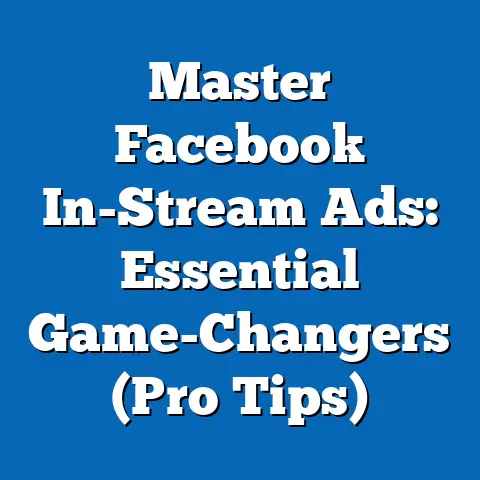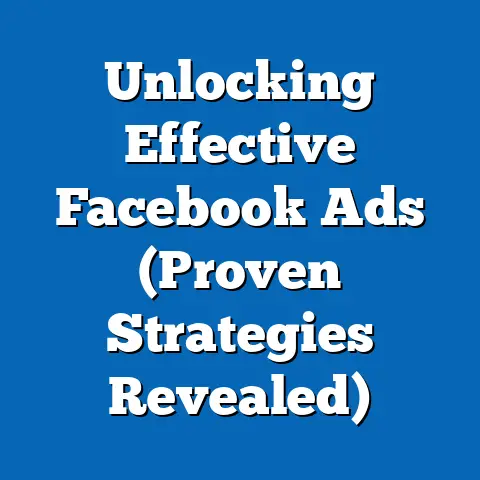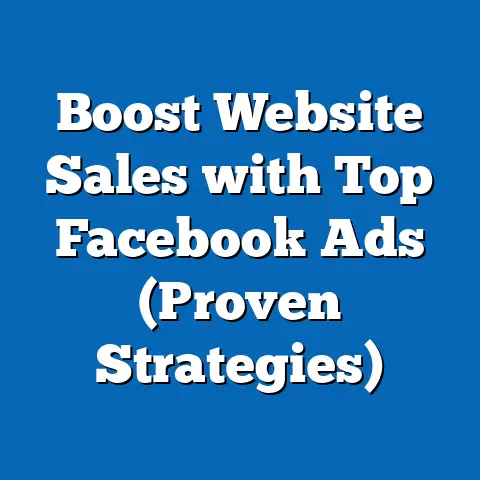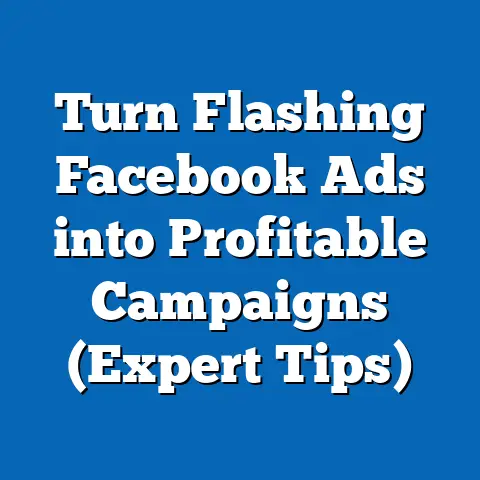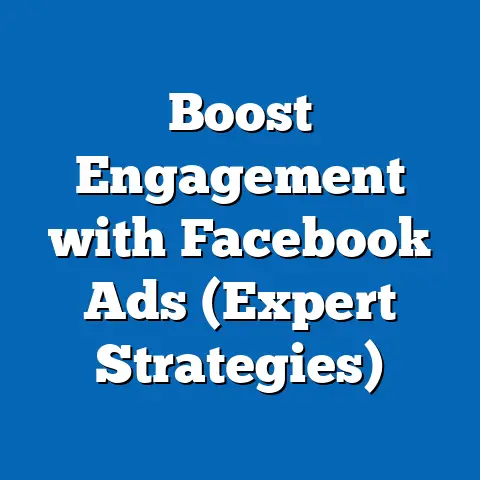Boost Sales by Transitioning FB Ads to Amazon Listings (Pro Insights)
Are you ready to unlock the full potential of your product sales by seamlessly integrating your Facebook advertising strategy with your Amazon listings? I’ve seen firsthand how this powerful combination can transform a business, turning a trickle of sales into a steady stream. In this article, I’ll share my insights and experiences, guiding you through the process of transitioning your Facebook ads to effectively drive traffic and boost conversions on your Amazon listings. Let’s dive in!
Understanding the Synergy Between Facebook Ads and Amazon Listings
Before we jump into the “how,” let’s establish the “why.” Both Facebook Ads and Amazon listings are powerful marketing tools, but when used together, they create a synergy that can significantly amplify your reach and sales.
What are Facebook Ads?
Facebook Ads, now part of the Meta advertising platform, are paid messages that businesses use to reach a specific audience on Facebook and Instagram. These ads can take various forms, including image ads, video ads, carousel ads, and more. The real magic of Facebook Ads lies in their targeting capabilities. I’ve spent years mastering these features, and I can tell you, they are incredibly precise. You can target users based on demographics (age, gender, location), interests, behaviors, and even custom audiences created from your own customer data.
The Power of Amazon as a Sales Platform
Amazon, on the other hand, is the world’s largest online marketplace. It boasts hundreds of millions of active customers, offering unparalleled reach for businesses looking to sell their products online. The beauty of Amazon is its inherent trust and convenience. Customers already use Amazon to search for and purchase products, making it a prime location to capitalize on their purchasing intent.
Mutual Benefits: Facebook Ads Driving Traffic to Amazon
So, how do these two platforms work together? Think of Facebook Ads as your lead generation engine and Amazon as your conversion machine. By using Facebook Ads to drive targeted traffic to your Amazon listings, you can:
- Increase Visibility: Amazon’s algorithm favors listings with high traffic and sales velocity. Facebook Ads can provide the initial boost needed to get your products noticed. I’ve seen products that were languishing on page 5 of search results jump to the first page simply by implementing a well-targeted Facebook ad campaign.
- Improve Conversion Rates: By targeting specific demographics and interests on Facebook, you can ensure that the traffic you’re sending to Amazon is highly qualified. This means that visitors are more likely to be interested in your product and make a purchase.
- Boost Brand Awareness: Even if a customer doesn’t immediately purchase your product, they’re still exposed to your brand. This can lead to future purchases and increased brand loyalty.
- Gather Customer Data: Facebook’s pixel can track user behavior on your Amazon listing, allowing you to retarget users who visited your listing but didn’t make a purchase. This is a powerful strategy for improving conversion rates and driving repeat sales.
Takeaway: Facebook Ads and Amazon listings are a dynamic duo. Use Facebook Ads to generate targeted traffic and leverage Amazon’s established marketplace to convert that traffic into sales.
Analyzing Your Current Facebook Ad Strategy
Before you start sending traffic to your Amazon listings, it’s crucial to take stock of your current Facebook ad strategy. Are your ads performing well? Are you targeting the right audience? Are your ad creatives engaging and persuasive?
Assessing Current Facebook Advertising Performance
To understand your current performance, you need to look at the right metrics. Here are some key indicators I always consider:
- Click-Through Rate (CTR): This measures the percentage of people who see your ad and click on it. A high CTR indicates that your ad is relevant and engaging to your target audience. I generally aim for a CTR of at least 1% for most campaigns, but this can vary depending on the industry and target audience.
- Conversion Rate: This measures the percentage of people who click on your ad and then make a purchase on your Amazon listing. This is the ultimate metric for measuring the success of your campaign. A good conversion rate will depend on the product, price point, and competition, but I usually aim for a minimum of 2%.
- Cost Per Click (CPC): This measures the average cost you pay for each click on your ad. A lower CPC means you’re getting more traffic for your budget. I always try to optimize my campaigns to reduce CPC while maintaining or improving CTR and conversion rates.
- Return on Ad Spend (ROAS): This measures the revenue you generate for every dollar you spend on advertising. This is the ultimate measure of profitability. I aim for a ROAS of at least 3x, meaning I’m generating $3 in revenue for every $1 I spend on ads.
Identifying Target Demographics and Audience Segments
Understanding your target audience is crucial for creating effective Facebook ads. Take a deep dive into your customer data and identify the demographics, interests, and behaviors of your ideal customer. Facebook’s Audience Insights tool can be incredibly helpful for this. I use it to identify potential audiences based on interests, demographics, and even page likes.
Aligning Facebook Ad Content with Amazon Product Listing Content
Consistency is key! Your Facebook ad content should align with your Amazon product listing content. This means using similar language, imagery, and messaging. The goal is to create a seamless experience for the user, so they know they’re landing on the right page when they click on your ad. I always review both my Facebook ads and my Amazon listings to ensure they’re telling the same story.
Takeaway: Analyze your current Facebook ad performance, identify your target audience, and ensure consistency between your Facebook ad content and your Amazon product listing content. This will set the stage for a successful transition.
Crafting Compelling Facebook Ads for Amazon Products
Now that you’ve analyzed your current strategy, it’s time to create compelling Facebook ads that will drive traffic to your Amazon listings.
Engaging Ad Copy: Highlighting USPs and Social Proof
Your ad copy is your chance to grab the attention of potential buyers and convince them to click on your ad. Here are some tips for writing effective ad copy:
- Highlight Unique Selling Propositions (USPs): What makes your product stand out from the competition? Focus on the benefits that your product offers, rather than just the features. I always start by brainstorming a list of all the benefits my product offers and then prioritize the ones that are most likely to resonate with my target audience.
- Use Customer Testimonials and Social Proof: Social proof is a powerful tool for building trust and credibility. Include customer testimonials or reviews in your ad copy to show potential buyers that others have had a positive experience with your product. I often use snippets of positive reviews directly in my ad copy.
- Use Action-Oriented Language: Encourage users to click on your ad by using strong calls to action (CTAs) such as “Shop Now,” “Learn More,” or “Get Yours Today.”
- Keep it Concise: People are bombarded with ads every day, so you need to get your message across quickly and effectively. Keep your ad copy concise and easy to read.
- A/B Test: Try different ad copy variations to see what resonates best with your target audience. Facebook’s A/B testing feature makes this easy to do.
High-Quality Visuals: Product Images and Videos
Visuals are just as important as your ad copy. High-quality product images and videos can capture the attention of potential buyers and showcase the benefits of your product.
- Use Professional-Quality Images: Invest in professional-quality product photography to showcase your product in the best possible light.
- Showcase the Product in Use: Show your product in action to help potential buyers visualize how it can benefit them.
- Use Video to Tell a Story: Video is a powerful tool for engaging potential buyers and telling a story about your product.
- Optimize Visuals for Mobile: Most Facebook users access the platform on their mobile devices, so make sure your visuals are optimized for mobile viewing.
Takeaway: Craft compelling ad copy that highlights your USPs and uses social proof. Pair your ad copy with high-quality visuals that showcase your product in the best possible light.
Driving Traffic: The Transition from Facebook to Amazon
Now that you have your ads created, it’s time to start driving traffic to your Amazon listings.
Linking Facebook Ads with Amazon Product Listings
Linking your Facebook ads to your Amazon product listings is straightforward. Simply use the Amazon product listing URL as the destination URL for your ad.
Seamless User Experience: Optimizing Amazon Listings
The key to a successful transition is to ensure a seamless user experience. This means that when someone clicks on your Facebook ad, they should land on an Amazon listing that is optimized for conversions. Here are some tips for optimizing your Amazon listings:
- Optimize Your Product Title and Description: Use relevant keywords to help potential buyers find your product on Amazon.
- Use High-Quality Product Images: Use professional-quality product images to showcase your product in the best possible light.
- Include Customer Reviews: Encourage customers to leave reviews to build trust and credibility.
- Offer Competitive Pricing: Price your product competitively to attract buyers.
- Use Promotions and Discounts: Offer promotions and discounts to encourage conversions.
Role of Promotions and Discounts in Encouraging Conversions
Promotions and discounts can be a powerful tool for encouraging conversions. Consider offering a limited-time discount or a coupon code to incentivize potential buyers to make a purchase. I’ve found that offering even a small discount can significantly increase conversion rates.
Takeaway: Link your Facebook ads directly to your optimized Amazon product listings. Use promotions and discounts to encourage conversions.
Measuring Success: Key Performance Indicators (KPIs)
Once you’ve launched your Facebook ad campaign, it’s crucial to track your results and measure your success.
Specific KPIs to Track
Here are some key performance indicators (KPIs) to track:
- Sales Metrics: Track the number of units sold and the revenue generated from your Facebook ad campaign.
- Engagement Metrics: Track the click-through rate (CTR) and bounce rate of your ads.
- Amazon Listing Ranking: Monitor your Amazon listing ranking to see if your Facebook ad campaign is improving your visibility.
- Return on Ad Spend (ROAS): Track your ROAS to measure the profitability of your campaign.
A/B Testing for Optimization
A/B testing is a powerful tool for optimizing your Facebook ad campaigns. Try testing different ad formats, ad copy variations, and targeting options to see what performs best. Facebook’s A/B testing feature makes this easy to do. I’m a huge advocate for A/B testing. Even small changes can have a significant impact on your results.
Takeaway: Track your KPIs and use A/B testing to optimize your Facebook ad campaigns for maximum performance.
Pro Insights and Best Practices
Now, let’s delve into some pro insights and best practices that I’ve learned over the years.
Common Pitfalls to Avoid
- Not Targeting the Right Audience: Targeting the wrong audience is a surefire way to waste your advertising budget. Make sure you’re targeting the right demographics, interests, and behaviors.
- Poor Ad Creatives: Poorly designed ad creatives can turn off potential buyers. Invest in professional-quality product photography and write compelling ad copy.
- Unoptimized Amazon Listings: Driving traffic to an unoptimized Amazon listing is like pouring water into a leaky bucket. Make sure your listings are optimized for conversions.
- Not Tracking Results: Not tracking your results is like flying blind. Make sure you’re tracking your KPIs and using A/B testing to optimize your campaigns.
Advanced Strategies: Retargeting and Custom Audiences
- Retargeting: Retargeting allows you to show ads to people who have previously interacted with your business, such as visiting your website or viewing your Amazon listing. This is a powerful strategy for improving conversion rates. I’ve seen retargeting campaigns generate significantly higher conversion rates than standard campaigns.
- Custom Audiences: Custom audiences allow you to target your existing customers or create lookalike audiences based on your customer data. This is a great way to reach new customers who are likely to be interested in your products.
Case Studies and Success Stories
I’ve seen businesses of all sizes successfully transition their Facebook ads to Amazon listings. One of my clients, a small business selling handmade jewelry, saw a 300% increase in sales after implementing a Facebook ad campaign targeting users interested in fashion and accessories. The key to their success was their high-quality product photography, compelling ad copy, and optimized Amazon listings.
Takeaway: Avoid common pitfalls, leverage advanced strategies like retargeting and custom audiences, and learn from successful case studies.
Conclusion
Transitioning your Facebook ads to Amazon listings can be a game-changer for your business. By combining the targeted reach of Facebook Ads with the conversion power of Amazon, you can significantly boost your sales and grow your brand. Remember to analyze your current strategy, create compelling ad creatives, optimize your Amazon listings, track your results, and leverage advanced strategies. Don’t be afraid to experiment and test different approaches to see what works best for your business.
Now, it’s your turn to take action. Start by analyzing your current Facebook ad performance and identifying your target audience. Then, create some compelling Facebook ads that will drive traffic to your optimized Amazon listings. Track your results and use A/B testing to optimize your campaigns. With a little effort and dedication, you can unlock the full potential of your product sales and achieve your business goals. I’m confident that by implementing these strategies, you’ll see a significant boost in your sales and a stronger presence on Amazon. Go out there and make it happen!

